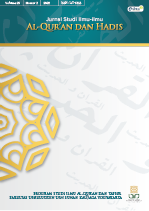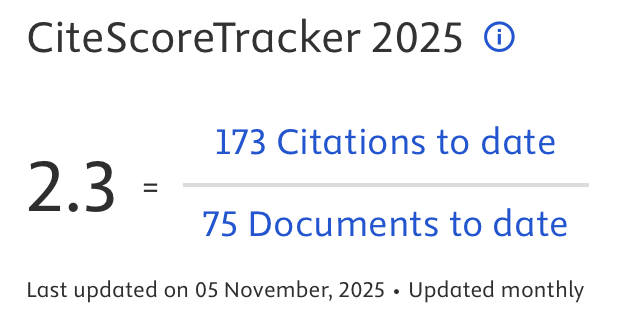The Quran and Muslim Minority Scholar’s Perspective: A Comparative Study of Abdullah Saeed and Farid Esack
DOI:
https://doi.org/10.14421/qh.v23i2.3277Keywords:
Minority Muslim scholar, contextual exegesis, liberation exegesis, hermeneuticsAbstract
This article discusses an alternative perspective in understanding the content of the Qur’an i.e., the perspective of minority Muslim scholars. The object of this study is the thought of tafsir Abdullah Saeed and Farid Esack who are positioned as Muslim scholars of Western institutions living as a minority, how their views of the Qur’an and how they develop interpretive methodologies according to the context of the environment in which they live. This article shows that the construction of the thought of Abdullah Saeed and Farid Esack positioned as minority scholars can represent its own contemporary model of interpretation. Abdullah Saeed with the idea of contextual interpretation laid out three bases of interpretive methodology: hierarchical values, contextual meaning, and systematic contextual interpretation. The three bases of the methodology are used to see the extent to which verses on ethical law can be understood and practiced in contemporary contexts while remaining grounded in the substance of the values carried when they are derived. While Farid Esack with his idea of liberative exegesis tried to break conservatism in South Africa with three methodological foundations: progressive revelation, reception hermeneutics, and the liberation theology of the Qur’an. The foundation of this methodology was used as a basis for value and legitimacy in supporting the agenda of popular solidarity between Muslims and non-Muslims in South Africa to overthrow the apartheid regime.
 Abstract viewed: 908 times
|
Abstract viewed: 908 times
|
 PDF downloaded = 622 times
PDF downloaded = 622 times
References
Abduh, Muhammad. 1994. Risalat Al-Tauhid. Beirut: Dar al-Syuruq.
Alalwani, Taha Jabir. 2003. Towards Fiqh For Minorities: Some Basic Reflections. London: The International Institute for Islamic Thought.
Allen, Christopher. 2004. “Justifying Islamophobia: A Post-9/11 Consideration of the European Union and British Context.” American Journal of Islamic Social Sciences 21(3): 1–25.
———. 2010. Islamophobia. Birmingham: Ashgate.
Arkoun, Mohammed. 2001. “Contemporary Critical Practices and the Quran.” In Encyclopaedia of the Quran, ed. Jane Dammen McAuliffe. Leiden: Brill, 412–31.
Asani, Ali S. 2002. “Pluralism, Intolerance and Quran.” The American Scholar 71(1): 52–60.
Auda, Jasser. 2007. Maqashid Al-Shari’ah as Philosophy of Islamic Law A System Approach. London: The International Institute of Islamic Thought.
Barnes-McConnell, Patricia W. 1989. “The Concept of Minority and the Organization of Social Control.” Soundings: An Interdisiplinary Journal 72(2): 551.
Berger, Peter L. 1986. The Capitalist Revolution & Fifty Propotitions About Prosperity, Equality, and Liberty. New York: Basic Books.
Burhani, Ahmad Najib. 2019. Menemani Minoritas: Paradigma Islam Tentang Keberpihakan Dan Pembelaan Kepada Yang Lemah. Jakarta: Gramedia Pustaka.
Dihlawi, Shah Waliyullah. 2005. Hujjat Allah Al-Balighah. Kairo: Dar al-Jil.
Esack, Farid. 1997. Quran, Liberation and Pluralism: An Islamic Perspective of Interreligious Solidarity against Oppression. Oxford: Oneworld.
———. 2007. The Quran A User’s Guide. Oxford: Oneworld.
———. 2018. “Progressive Islam – A Rose by Any Name? American Soft Power in the War for the Hearts and Minds of Muslims.” ReOrient 4(1): 78 – 106.
Esposito, John L. 2002. “Foreword.” In Muslim in the West: From Sojourners to Citizens, eds. Geoffrey Brahm and Tariq Modood. Oxford: Oxford University Press.
Fish, Stanley. 1980. Is There a Text in This Class? The Authority of Interpretive Communities. Cambridge: Harvard University Press.
Gadamer, Hans-Georg. 2004. Truth and Method. London: Continuum.
Ghozali, Abdul Moqsith. 2012. “Fikih Mayoritas Dan Fikih Minoritas: Upaya Rekonstruksi Fikih Lama Dan Merancang Fikih Baru.” Tashwirul Afkar 31(1): 42–63.
Haron, Muhammad. 2004. “The Alternative South African Muslim Press: Muslim News & Al-Qalam.” Islamic Studies 43(3): 461 – 462.
Hasan, Riaz, and Bill Martin. 2015. Islamophobia, Social Distance, and Fear of Terrorism in Australia. South Australia: International Center for Muslim and Non-Muslim Understanding.
Hassan, Rania. 2011. Identity Construction in Post-Apartheid South Africa: The Case of Muslim Community. Edinburgh: The University of Edinburgh.
Kelsey, David. 1975. The Uses of Scripture in Recent Theology. Philadelpia: Fortress Press.
Mahmood, Saba. 2015. “Minorities in Middle East: Ethnicity, Religion, and Support for Authoritarianism.” Political Research Quarterly 68(2): 280–92.
Mawardi, Ahmad Imam. 2010. Fiqh Minoritas: Fiqh Al-Aqalliyat Dan Evolusi Maqashid Al-Syariah Dari Konsep Ke Pendekatan. Yogyakarta: LKIS.
Nilbert, David. 1996. “Minority Group as Sociological Euphimism.” Race, Gender, & Class 3(3): 135.
Nurdin, M. Amin. 2009. Pergulatan Kaum Muslim Minoritas Australia: Islam Versus Multikulturalisme Dan Sekularisme. Jakarta: Ushul Press.
Nurlaelawati, Euis. 2010. Modernization, Tradition, and Identity: The Kompilasi Hukum Islam and Legal Practice in the Indonesian Religious Courts. Amsterdam: Amsterdam University Press.
Osborne, Grant R. 1991. The Hermeneutical Spiral: A Comprehensive Introduction to Biblical Interpretation. Downers Grove: Intervarsity Press.
Patombo, Matthew. 2014. “The Emergence of Islamic Liberation Theology in South Africa.” Journal of Religion in Africa 44(1): 28–61.
Rahman, Fazlur. 1975. Major Themes of the Quran. Chicago: University of Chicago.
Rippin, Andrew. 1985. “The Exegetical Genre of Asbab Nuzul: A Bibliographical and Terminological Survey.” Bulletin of School of Oriental and African Studies 48(1): 1–15.
———. 1988. “The Function of Asbab Nuzul in Quranic Exegesis.” Bulletin of School of Oriental and African Studies 51(1): 1–20.
Saeed, Abdullah. 1999. “Rethinking Revelation as Precondition for Reinterpreting the Quran: A Quranic Perspective.” Journal of Quranic Studies 1(1): 93 – 114.
———. 2003. Islam in Australia. New South Wales: Allen & Unwin.
———. 2006. Interpreting The Quran: Towards A Contemporary Approaches. London: Routledge.
———. 2008. The Quran: An Introduction. London: Routledge.
———. 2009. “Muslim in the West and Their Attitudes to Full Participation in Western Societies: Some Reflection.” In Secularism, Religion and Multicultural Citizenship, eds. Geoffrey Brahm and Tariq Modood. Cambridge: Cambridge University Press, 207–10.
———. 2014. Reading the Qur’an in the Twenty-First Century: A Contextualist Approach. London: Routledge. https://www.routledge.com/Reading-the-Quran-in-the-Twenty-First-Century-A-Contextualist-Approach/Saeed/p/book/9780415677509.
———. 2019. “Reading the Quran Contextually: Approaches and Challenges.” In New Trends in Quranic Studies: Text, Context, and Interpretation, Atlanta: Lockwood Press.
Setiawan, Nur Kholis. 2006. Al-Qur’an Kitab Sastra Terbesar. Yogyakarta: ELSAQ Press.
Seyranian, Viviane. 2008. “Dimensions of Majority and Minority Groups.” Group Process & Intergroup Relation 11(1).
Suaedy, Ahmad. 2018. Islam, Minorities and Identitiy in Southeast Asia. Depok: Inklusif.
Suyuthi, Jalal al-Din. 2008. Al-Itqan Fi ‘Ulum Al-Qur’An. Beirut: Muassasat al-Risalah.
Syamsuddin, Sahiron. 2017. Hermeneutika Dan Pengembangan Ulumul Quran. Yogyakarta: Baitul Hikmah Press.
Wagley, Charles, and Marvin Harris. 1959. Minorities in the New World: Six Case Studies. New York: Columbia University Press.
Wirth, Louis. 1945. “The Problem of Minority Group.” In The Science of Man in the World Crisis, ed. R. Linton. New York: Columbia University Press, 347.
Young, Donald. 1937. Research Memorandum on Minority People in the Depression. New York: Social Science Research Council.
Downloads
Published
How to Cite
Issue
Section
License
Copyright (c) 2022 Wildan Imaduddin Muhammad

This work is licensed under a Creative Commons Attribution-NonCommercial-NoDerivatives 4.0 International License.
Publishing your paper with Jurnal Studi Ilmu-ilmu al-Qur'an dan Hadis means that the author or authors retain the copyright in the paper. Jurnal Studi Ilmu-ilmu al-Qur'an dan Hadis uses license CC-BY-NC-ND or an equivalent license as the optimal license for the publication, distribution, use, and reuse of scholarly works. This license permits anyone to copy and redistribute the material in any medium or format and must give appropriate credit, provide a link to the license, and indicate if changes were made. If you remix, translate, transform or build upon the material you may use it for private use only and not for distribution. Jurnal Studi Ilmu-ilmu al-Qur'an dan Hadis granted an exclusive non-commercial reuse license by the author(s), but the author(s) are able to put the paper onto a website, distribute it to colleagues, give it to students, use it in your thesis, etc, so long as the use is not directed at a commercial advantage or toward private monetary gain. The author(s) can reuse the figures and tables and other information contained in their paper published by Jurnal Studi Ilmu-ilmu al-Qur'an dan Hadis in future papers or work without having to ask anyone for permission, provided that the figures, tables, or other information that is included in the new paper or work properly references the published paper as the source of the figures, tables or other information, and the new paper or work is not direct at a private monetary gain or commercial advantage.
Jurnal Studi Ilmu-ilmu al-Qur'an dan Hadis journal Open Acces articles are distrubuted under the Creative Commons Attribution-NonCommercial-NoDerivatives 4.0 International (CC BY-NC-ND 4.0). Article can be read, copy and redistribute the material ini any medium or format under the following conditions:
Attribution — You must give appropriate credit, provide a link to the license, and indicate if changes were made. You may do so in any reasonable manner, but not in any way that suggests the licensor endorses you or your use.
NonCommercial — You may not use the material for commercial purposes.
NoDerivatives — If you remix, transform, or build upon the material, you may not distribute the modified material.










